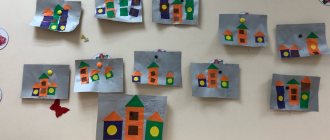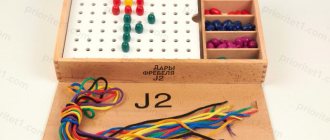Teacher’s methodological cheat sheet “Structure of classes according to Federal State Educational Standards up to”
Elena Tarakina
Teacher’s methodological cheat sheet “Structure of classes according to Federal State Educational Standards up to”
Preparing the teacher for the lesson :
• Preparing a teacher for classes consists of three stages:
• Lesson ;
• Preparation of equipment;
• Preparing children for classes .
• Lesson :
• Select program content, outline methods and techniques , think through the course of the lesson .
• Make a plan - a summary, which includes:
• -program content (educational objectives)
;
• -equipment;
• -preliminary work with children (if necessary)
;
• - course of the lesson and methodological techniques .
•Equipment preparation:
• On the eve of the lesson , select the equipment, check whether it is in working order, whether there is enough teaching material, etc.
• Some activities require longer preliminary preparation (for example, if you need to show sprouted onions, they need to be sprouted in advance).
• When planning an excursion, the teacher must go to the site in advance, identify objects to observe, and think over the shortest and safest route.
• Preparing children for classes
• Creating interest in the upcoming work
• Warning children about the start of the lesson in advance (10 minutes in advance, so that the children have time to finish their games and get ready for the lesson
• Organizing the work of duty officers to prepare for the lesson
Lesson structure:
• The lesson includes three stages:
• 1. Organization of children;
• 2. Main part of the lesson ;
• 3. End of class .
•Organization of children:
– Checking children’s readiness for class (appearance, concentration)
;
– Creating motivation and interest in the lesson (techniques that contain entertainment, surprise, mystery)
.
•
• Main part of the lesson :
• Organization of children's attention;
• Explaining the material and showing the method of action or setting a learning task and joint solution (3-5 min)
;
• Consolidation of knowledge and skills (repetition and joint exercises, independent work with didactic material.
•
• End of class :
• Summing up (analysis together with the children of completed work, comparing the work with didactic tasks, assessing the children’s participation in the lesson , reporting what they will do next time);
• Switching children to another type of activity.
•
Threefold objective of the lesson :
•Educational: increase the level of child development
•Educational: to form the moral qualities of the individual, views and beliefs.
•Developing: when teaching, develop students’ cognitive interest, creativity, will, emotions, cognitive abilities - speech, memory, attention, imagination, perception.
Non-traditional activities :
Non-traditional form Contents
Lesson – creativity Verbal creativity of children using TRIZ technology “We compose fairy tales “inside out”
,
“Let’s invent a non-existent animal. Plant"
.
Lesson - gatherings Introducing preschoolers to children's folklore at traditional folk gatherings, which involve the integration of various types of activities.
Lesson - fairy tale Speech development of children in the framework of various types of activities, united by the plot of a fairy tale that is well known to them.
Lesson – press conference of journalists Children ask questions to the “astronaut”
, heroes of fairy tales and others, can be implemented through the project activity
“Young Journalists”
.
Lesson - travel Organized trip to your hometown, art gallery. The children themselves can act as guides.
Lesson - experiment Children experiment with paper, fabric, sand, snow.
Lesson - competition Preschoolers participate in competitions held by analogy with the popular television competitions KVN, “What? Where? When?"
,
“Smart Men and Smart Girls”
and others.
Lesson – drawings and essays
Children write fairy tales and stories based on their own drawings.
LESSON STRUCTURE:
• 1. Motivation.
The teacher is simply obliged to provide children with “freedom of choice”
upcoming activities and, at the same time, with your skill to captivate children with you.
For example, the teacher of the first junior group during an educational lesson told the children the fairy tale “Kolobok”
, and then offered motivation for the upcoming activity
(collective application of the character Kolobok)
“Guys, Kolobok ran away from his grandparents, they are crying bitterly. How can we help our grandparents? Then it offers possible answers: maybe we should draw a Kolobok and give it to our grandparents? Thus, she captivated the children, organized motivation for drawing, got them interested, and also solved the educational task: to make the children want to help their grandparents in finding Kolobok.
Features of work on creating gaming motivation for
different age stages:
Younger age - the motivation is in the material itself, so there is no point in inviting Dunno! Enough motivation! Each child has his own material - this is important! The material poses the challenge itself! The problem is to motivate them before they start acting on it themselves.
Middle group - you can bring a character because at this age children have already mastered the roles.
Senior group - (plots, plot composition)
– the main thing is not the characters, but the plots
(he handed over a letter, the character himself is not there, but there is a letter)
.
Plots can be long (travel in a time machine)
. In the course of direct educational activities, small paraphernalia, established roles, and changing roles can be used.
Preparatory group - games with rules, children ensure that the rules are followed. A competitive game with a winning mindset is used (chips are used)
. Give every child the opportunity to experience situations of winning and losing.
In the absence of motivation, there is no development of logic.
• 2. Rely on children's knowledge
Children are offered a game, a subject activity with dialogue, during which they remember what will help them get acquainted with a new topic (updating knowledge and skills)
.
• 3. Problem in the game situation
At the end of the game, a difficulty should arise, which the children record in speech. (Why couldn’t we? We don’t know this yet, we don’t know how.)
.
The teacher encourages them to ask questions and, together with the children, determines the topic of the upcoming activity. As a result, the children conclude that it is necessary to think about how everyone can get out of a difficult situation together (joint goal setting and planning)
.
For example, children need to help the Chicken find chickens. The teacher can ask : “Do you want to help the Hen find the chickens?
How can this be done? That is, the question is problematic in nature and forces children to think through answer options: call the chickens, go after them, etc.
• 4. Solving the problem. Discovering new knowledge or skill
The teacher , using introductory dialogue based on play activities, leads children to discover new knowledge or skills. Having formalized new knowledge or skill in speech, children return to the situation that caused the difficulty and overcome it using a new method of action.
• 5. Consolidating new things in a typical situation
At this stage, games are played where children use new knowledge or skills (a game situation is created that records each child’s individual mastery of new material).
• 6. Summary of GCD
Children record in their speech what new things they have learned, where new knowledge and skills will be useful. At the end of the ECD, the teacher sums up the results together with the children, involving the children in self-assessment (mutual assessment)
performance results.
Age stages of verification:
• Young age - when pointing out to a child a particular shortcoming in his activity, it is important to emphasize what inconveniences or difficulties this creates for the game character. (The child drew a house without windows; the teacher, on behalf of the bunny, can say that he is afraid to sit in the dark.) At this age, assessment occurs during the course of the educational activity itself, and not at the end. At the same time, comments and tips (how to fix)
should come not from
the teacher , but from the game character (the little bunny, not the teacher, asks the child to draw the windows in the house)
.
With children who completed the task before others, the teacher conducts individual conversations (on the educational and gaming content of the educational activity itself; it is advisable to structure the conversation as a conversation between two game characters, a little hare and a hare).
Middle age - the child learns to correlate the result obtained with the goal he has set and evaluate the work performed from the point of view of qualities that are significant to him.
By accepting a certain role and acting in it (in the role of a bunny, a child builds a house for himself), the child calmly accepts the teacher’s and does not react negatively to his failure. He treats criticism as a reminder to follow certain rules of the game that an adult plays with him. Thanks to this, children have a desire to finish the job they started and achieve results.
Older age – special attention should be paid to the formation of self-esteem and self-control. It is very important to organize the learning process so that every child achieves the desired result in any activity. Just like at a younger age, a child rejoices at success, and failure leads to confusion and refusal to work. The task of an adult is to teach children not to dramatize failures, but to treat them as a natural process. “He who does nothing makes no mistakes”
.
Teaching methods and techniques:
• 2nd junior group
• The lesson begins with elements of the game, surprise moments - the unexpected appearance of toys, the arrival of “guests”
etc. During
the lesson , gaming techniques and didactic games are used.
• Demonstration and handout material should be large. duration 10 minutes . The lesson is conducted in subgroups.
• Middle group
• Visual and effective teaching methods are used: the teacher examples and methods of action, children perform practical tasks, including elementary mathematical activities (establishing correspondence between the numbers of sets, counting, etc.)
Exploratory activities, such as tactile-motor examinations.
• Lesson duration 20 minutes . The lesson is conducted in subgroups.
• Senior group
• Visual, verbal and practical methods are used in combination. Five-year-old children are able to understand the cognitive task set by the teacher and act in accordance with his instructions. Setting a task awakens cognitive activity in children. (For example, “How do you know how much longer a table is than its width?”
)
• The types of visual aids are expanded, and their nature changes somewhat.
• Toys and things continue to be used as illustrative material. A large place is occupied by working with pictures, with color and silhouette images of objects , and the drawings of objects can be schematic.
• “Deputies”
real
objects . The role of verbal teaching methods is increasing: “How else can you do it?
Check? Say?" Verbal games and exercises are widely used:
“Say the opposite!” “Who can name it faster?”
.
• Lesson duration 25 minutes . The lesson is conducted by the whole group.
• Preparatory group
• As in the older group. duration 30 minutes . Conducted 2 times a week by the whole group.
Structure of different types of lessons
Lessons on the Federal State Educational Standard are based on a system-activity approach. Such lessons can be divided into the following types:
- lessons of introduction (“discovery”) of new knowledge (ONZ);
- reflection lessons;
- lessons of general methodological orientation;
- lessons of developmental control.
The structure of a lesson according to the Federal State Educational Standard may differ slightly. For example, in EHS lessons there may be no stage of checking homework completion. There will be no learning of new material during reflection lessons. All stages are most fully traced in lessons with a general methodological orientation.
Structure of developmental control lessons
This type of lessons can be compared to traditional lessons, when tests are carried out first, and in the next lesson, mistakes are worked on. The fundamental difference is that in these lessons the emphasis is on self-control, on the development of self-analysis in students. In such lessons, students continue to develop their control and assessment abilities. They are carried out after studying a large block of material and take two hours, so they are more often used in teaching subjects such as mathematics, Russian, and physics.
Developmental control lessons consist of the following stages.
| 1 lesson | Motivation for control and corrective actions | It is required that students prepare for the test, understand its necessity, and feel confident. |
| Update and trial action | Knowledge on the topic is being updated. Control work is being carried out. Then a self-test is carried out against the standard. Students check their work and grade themselves, but do not correct mistakes. | |
| In the interval between two lessons, the teacher himself checks the work and gives grades for them. | ||
| Lesson 2 | Localization of difficulties | Students identify their mistakes and difficulties. |
| Goal setting and construction of a plan for correcting identified difficulties | Students must choose individual goals for themselves and determine means and ways to solve difficulties. | |
| Project implementation | Students work on a draft. For those who have made the same mistakes, work in groups is possible. | |
| Summary of Difficulties | The difficulties, the chosen ways to resolve them, and the solution algorithm must be discussed. Explain why they chose this particular path. | |
| Independent work with checking against the standard | Students work independently on those tasks for which difficulties arise. They check the sample and answer the question whether the difficulties have been resolved, whether the errors have been corrected. | |
| Inclusion in the knowledge system | To consolidate the acquired knowledge, tasks similar to the previous ones are performed, but more creative. | |
| Reflection | Students analyze their work in class. If necessary, homework is given. | |





